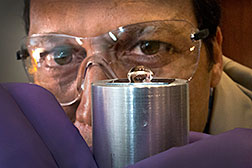- Number 400 |
- November 4, 2013
Nano-cone textures generate extremely ‘robust’ water-repellent surfaces

Antonio Checco.
When it comes to designing extremely water-repellent surfaces, shape and size matter. That's the finding of a group of scientists at DOE's Brookhaven Lab who investigated the effects of differently shaped, nanoscale textures on a material's ability to force water droplets to roll off.
"The idea that microscopic textures can impart a material with water-repellent properties has its origins in nature," explained lead author Antonio Checco. "For example, the leaves of lotus plants and some insects' exoskeletons have tiny-scale texturing designed to repel water by trapping air. This property, called 'superhydrophobicity' (or super-water-hating), enables water droplets to easily roll off, carrying dirt particles along with them."
Mimicking this self-cleaning mechanism of nature is relevant for a wide range of applications, such as non-fouling, anti-icing, and antibacterial coatings. However, engineered superhydrophobic surfaces often fail under conditions involving high temperature, pressure, and humidity—such as automotive and aircraft windshields and steam turbine power generators—when the air trapped in the texture can be prone to escape. So scientists have been looking for schemes to improve the robustness of these surfaces by delaying or preventing air escape.
The Brookhaven scientists developed a fabrication approach based on self-assembly of nanostructures, allowing precision control. The scientists created and tested new materials with different nanoscale textures—some decorated with tiny straight-sided cylindrical pillars and some with angle-sided cones. They were also able to control the spacing between these nanoscale features to achieve robust water repellency. The research revealed that cone-shaped nanostructures are significantly better than cylindrical pillars at forcing water droplets to roll off the surface, thus keeping surfaces dry. The water-repelling ability of cone-shaped nanotexturing held up even when water droplets were sprayed onto the surface with a pressurizing syringe—an effect captured using a high-speed camera.
The team is working on extending this technique to other materials, including glass and plastics, and on fabricating surfaces that are also oil-repellent by further tweaking the feature shape.
[Karen McNulty Walsh, 631.344.8350,
kmcnulty@bnl.gov]
